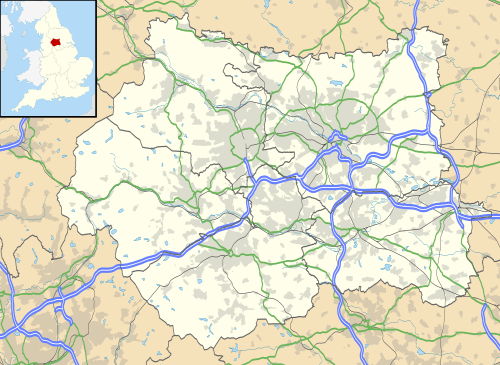Oakworth
| Oakworth | |
|---|---|
 Keighley Road, Oakworth | |
 Oakworth Oakworth shown within West Yorkshire | |
| OS grid reference | SE0338 |
| Metropolitan borough |
|
| Shire county |
|
| Region | |
| Country | England |
| Sovereign state | United Kingdom |
| Post town | Bradford |
| Postcode district | BD22 |
| Police | West Yorkshire |
| Fire | West Yorkshire |
| Ambulance | Yorkshire |
| EU Parliament | Yorkshire and the Humber |
Oakworth is a borough in the Town of Keighley in West Yorkshire, England, by the River Worth. The name "Oakworth" indicates that the area was first established in a heavily wooded area.
Oakworth railway station is on the route of the Keighley and Worth Valley Railway and was a location in the film The Railway Children.[1]
History
On folio 301v of the Domesday Book of 1086, Oakworth is called "Acurde"[2] which translated into an Oak clearing. It was taxed on c120 acres (c50 hectares) of arable ploughland shared by the Vikings Vilts and Gamel Bern.[3] Vilts also owned Newsholme and Utley; and Gamel Bern was of the family of noblemen that held the most land in Northern England. However later, on folio 327r, the Domesday Book states of Oakworth lands that "Gamal Bern had them; Gilbert Tison has them" for in the Harrying of the North all lands were taken from Anglo-Scandinavians and given to Norman Lords.
Landmarks
Holden Park in Oakworth occupies the grounds of an historic house owned by Sir Isaac Holden, an inventor who is said to have invented the lucifer match and revolutionised the process of wool carding.[4] After Holden's death in 1897, his house, called Oakworth House, and its contents were sold at auction, and the house was all but destroyed by fire in 1907.[5] All that remains of the original building is the portico.[6]
Education
Oakworth Primary School is situated in the grounds of Sir Isaac Holden's estate, along with Holden Park. The school playground has sloping sides because it was once a lake in the ornamental gardens in front of Oakworth House.[7] The school is attended by children aged between 3 - 11. It has gone through many changes since it was first built. Its original name was 'Oakworth First School', which taught children up to the age of 9, when children would then progress to middle school. This system changed in 2000, so that Oakworth Primary School expanded to cover years 5 and 6.[8]
See also
References
- ↑ "The Railway Children | KWVR - Keighley & Worth Valley Railway". KWVR - Keighley & Worth Valley Railway. 10 September 2014. Retrieved 12 January 2017.
- ↑ "Domesday Book Oakworth". National Archives. Retrieved 12 January 2017.
- ↑ Powell-Smith, Anna. "Oakworth | Domesday Book". opendomesday.org. Retrieved 12 January 2017.
- ↑ "Holden, Sir Isaac, first baronet (1807–1897), inventor of a wool-combing machine, entrepreneur, and politician | Oxford Dictionary of National Biography". oxforddnb.com. doi:10.1093/ref:odnb/9780198614128.001.0001/odnb-9780198614128-e-13491. Retrieved 3 January 2018. (Subscription required (help)).
- ↑ "Oakworth conservation area assessment" (PDF). bradford.gov.uk. Bradford Council. October 2005. p. 8. Retrieved 12 January 2017.
- ↑ "Oakworth conservation area assessment" (PDF). bradford.gov.uk. Bradford Council. October 2005. p. 13. Retrieved 12 January 2017.
- ↑ "Oakworth conservation area assessment" (PDF). bradford.gov.uk. Bradford Council. October 2005. p. 12. Retrieved 12 January 2017.
- ↑ "Oakworth Primary School inspection report" (PDF). ofsted.gov.uk. Ofsted. May 2001. p. 6. Retrieved 12 January 2017.
External links
| Wikimedia Commons has media related to Oakworth. |